
Looking for the best ChatGPT prompts for grant writing? You’re in the right place. Whether you’re applying for nonprofit funding or project support, these ready-to-use prompts will help you write faster, sound more persuasive, and impress any funder – no guesswork needed.
Grant writing is a vital skill, but it’s often complex and time-consuming. Luckily, AI tools like ChatGPT can help you manage these challenging and time-intensive tasks more effectively.
In fact, according to research, 48% of funders and 66% of nonprofit professionals report that their organizations are currently using some form of AI. Even more, 78% of funders and 77% of nonprofits believe their organizations could benefit from expanded AI adoption. That’s why letting ChatGPT guide your grant writing can be a smart move – especially if you’re unsure where to start. Explore our handy prompts below. (Source: hai.stanford.edu)
If you have no idea where to start, explore our handy ChatGPT prompts for grant writing, which ensure you’ll conquer each part of the process. Let’s begin!
ChatGPT can help you at various stages of grant writing, from finding funding opportunities to polishing your proposals. To get the best results, start with a clear strategy like the one below:
Before you start using ChatGPT, question yourself: ”What is the main goal of your project?” “What problem are you trying to solve?”. As you have clear objectives, ChatGPT can help you generate relevant content.
The more information you provide, the better ChatGPT can help. ChatGPT needs detailed context to generate high-quality proposals.
Instead of just saying, “Write a grant proposal,” explain who you are, what your project is, who it helps, and why it’s important. You can also share previous drafts or background info for reference.
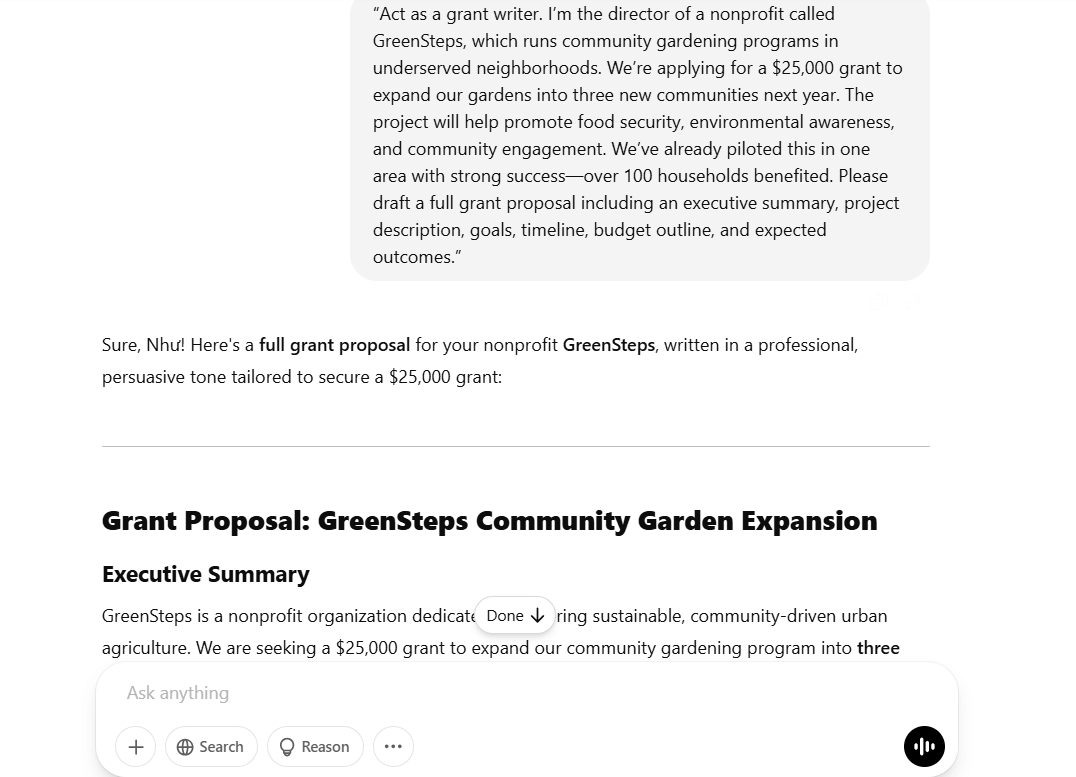
Example of Giving a Detailed Context for a Grant-writing Prompt
Use ChatGPT in stages. Start with a basic draft, then ask for suggestions, edits, or rewrites focusing on things like tone or clarity. Ask follow-up questions and make adjustments until it sounds just right.
AI is powerful, but it’s still not perfect. ChatGPT is a fantastic assistant – not a replacement for your expertise. It doesn’t access real-time grant databases and may generate content that sounds right but isn’t always accurate. So, always review and personalize what it creates to ensure it aligns with your goals and the funder’s requirements.
It’s time to explore some useful prompts to guide you through each step of the grant writing process.
Before writing your proposal, you need to find the right funding options. Here are some prompts that can help you identify grants that fit your project’s goals:
Identifying Relevant Grants
Prompt:
“As a professional grant researcher, find current grant opportunities related to [your field or project focus, e.g., ‘community gardening, urban agriculture, etc’]. Please include the grant name, eligibility requirements, funding amount, application deadline, and a direct link to each program.”
This prompt will help you find the most relevant funding opportunities based on your specific project. You should be clear about your focus to get the best results.
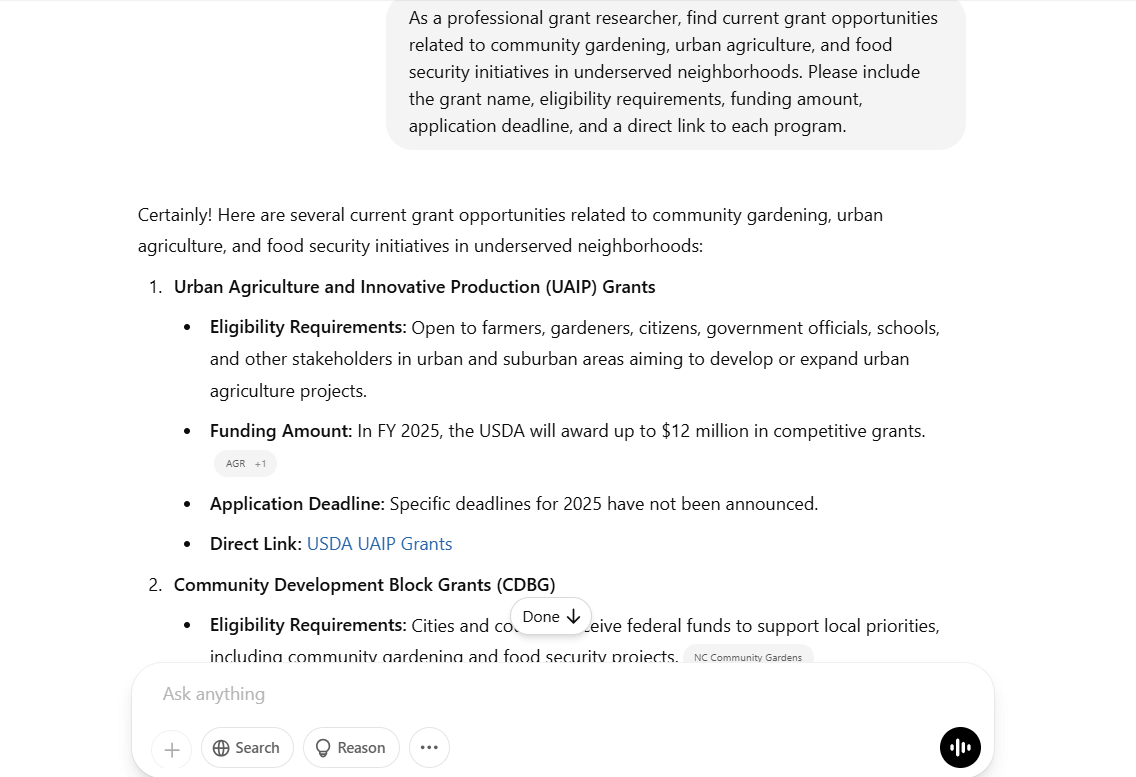
ChatGPT Response When Asking Relevant Grants
Researching Funding Organizations
Prompt:
“Act as a grant funding expert. Identify organizations that support projects in [your focus area, e.g., community gardening, urban agriculture]. Please list each organization with a brief description, their typical grant programs, the types of projects they fund, contact details, and links to application guidelines.”
Once you’ve found some grants, it’s helpful to know more about the organizations offering them. This prompt will help you gather that information.
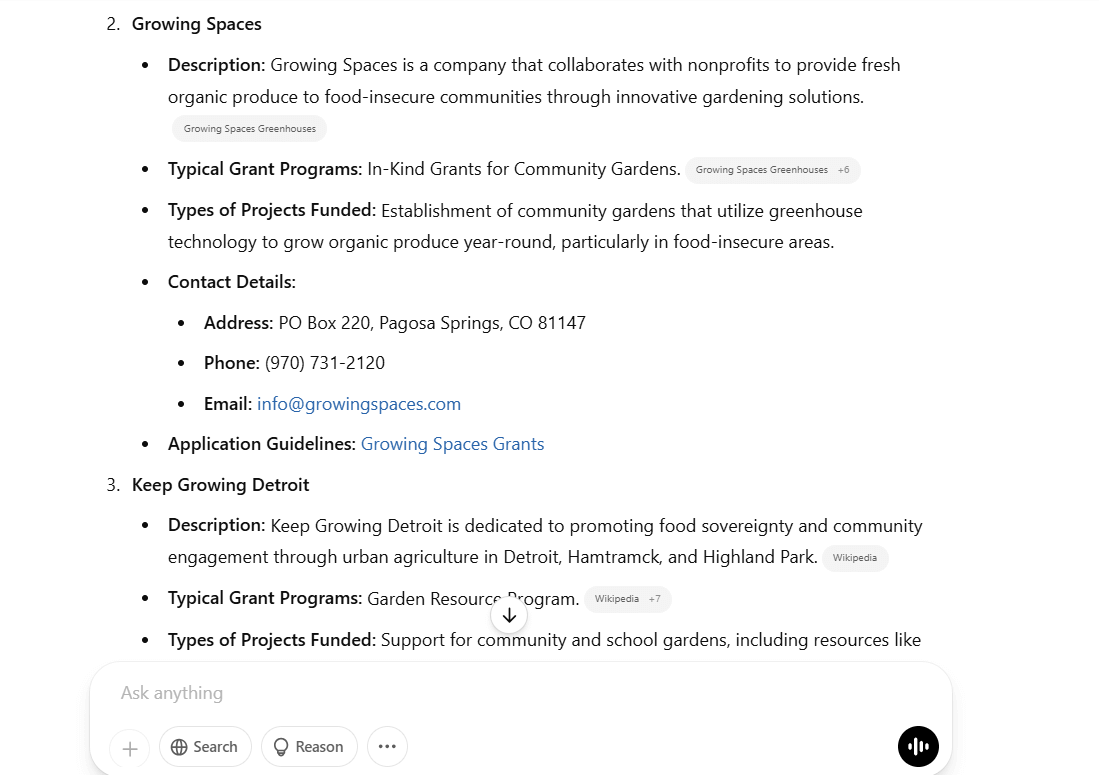
ChatGPT Response When Asking for Funding Organizations
Once you have a list of potential funders, it’s time to create a proposal that stands out. Keep scrolling to explore some tips that can help you create well-written proposals:
Crafting an Executive Summary
Prompt: “Write a summary for a grant proposal about [your project]. Include your project’s mission, who you’re targeting, key goals, timeline, and expected results in fewer than 300 words.”
Think of this as your project’s elevator pitch. First, you have to make it concise and clear, with the most crucial information to grab the funder’s attention right away.
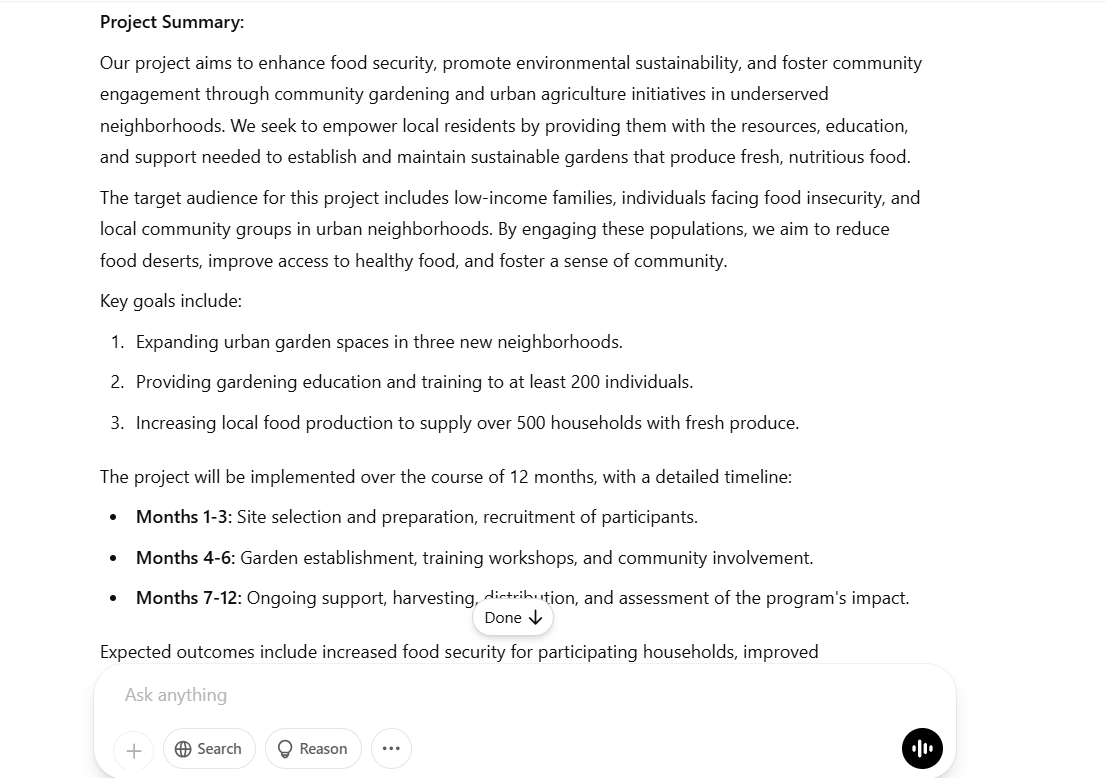
Project’s Summary Generated by ChatGPT Prompt for Grant Writing
Describing the Need
Prompt: “Draft a statement explaining why this project is needed. Discuss the problem it addresses, who it impacts, and why it’s urgent. Include a few relevant statistics.”
This part is crucial because you want to show why your project matters. We recommend making it compelling with some data!
Setting Goals
Prompt: “Define 3–5 clear goals for [your project] (e.g., ‘getting more girls interested in STEM’). Make sure they are specific, measurable, achievable, relevant, and time-based.”
Having clear goals helps funders see what you’re aiming for and how you plan to succeed.
Outlining Your Approach
Prompt: “Create a detailed implementation plan for [your project]. Break it into clear phases with timelines, key activities, required resources, and assigned team responsibilities for each stage.”
This section is crucial since it shows that you have a plan! Funders want to know that you can execute your ideas effectively.
Justifying Your Budget
Prompt: “As an experienced project budgeter, create a comprehensive budget breakdown for [your project] with a total of [$amount]. Include different categories (like staff, equipment, supplies, indirect costs) and explain how each cost contributes to your project’s success.”
Be transparent about your budget. Explain why each expense is necessary!
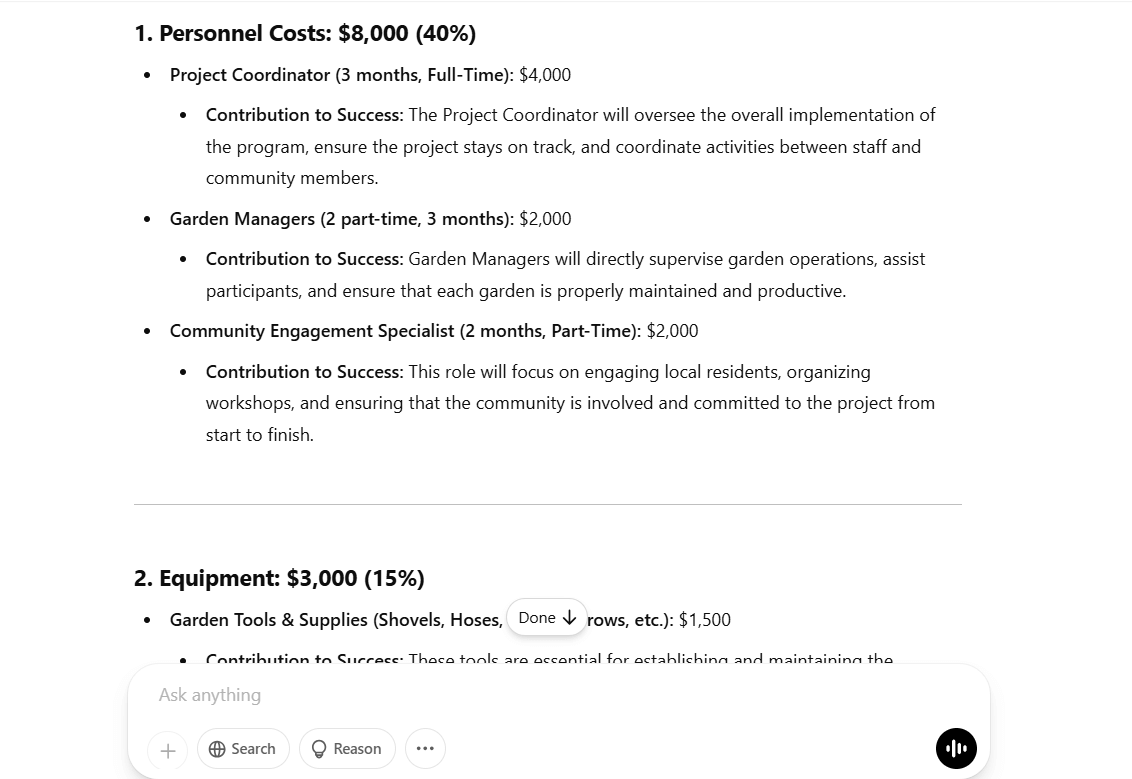
The Output When Inputting the Budget Justifying Prompt
Sometimes, your grant work also includes letters of intent or reports. Here are a couple of quick prompts to help with those:
Composing Letters of Intent
The first impression is the last impression. So, if you want to secure funding for your project, a well-crafted Letter of Intent (LOI) is key. It’s your chance to introduce your organization, explain your project, and show how it aligns with the funder’s goals.
Start with a warm introduction. Keep it brief but engaging. Use this simple prompt to guide you:
Prompt: “Write an introduction for a Letter of Intent (LOI) for a grant application to [Funder’s Name]. The project is [brief project description] aimed at [project’s main objective]. Mention how the project aligns with the funder’s mission and why it is a good fit for their funding priorities.”
Composing Progress Reports
Prompt: “Generate a progress report for [project name] funded by [funder name]. Share what you’ve accomplished so far, any challenges you faced, and what’s next.”
Well, this is a smart move to prove your reliability. Reporting on your progress can show funders how their money is being used and keep them engaged.
If you’re getting started with grant writing, you might find tools like ChatGPT helpful. The good news is that other platforms can help, too. One of them is Writesonic.

Writesonic Composes Progress Report
Unlike ChatGPT, Writesonic lets you customize proposals by entering details like the project type, focus area, funding amount, and who will benefit. In just a few clicks, you can create a draft that covers important sections, saving you lots of time. You can even save templates for future proposals.
After you have your draft from Writesonic, you can use ChatGPT to polish it, like adjusting the tone or adding more details. It’s worth combining these advantages from both tools to create the engaging grant proposals that you wish. Give them a try!
You may be interested in: Can ChatGPT Write Erotica? A Guide to Crafting Sensual Stories with AI
Grant writing is quite overwhelming. So, if there’s any chance to simplify the process, take it. Here are three friendly ones to help you.
Prompt chaining is about breaking the big task down into smaller steps. For example, you could use prompt chaining like this:
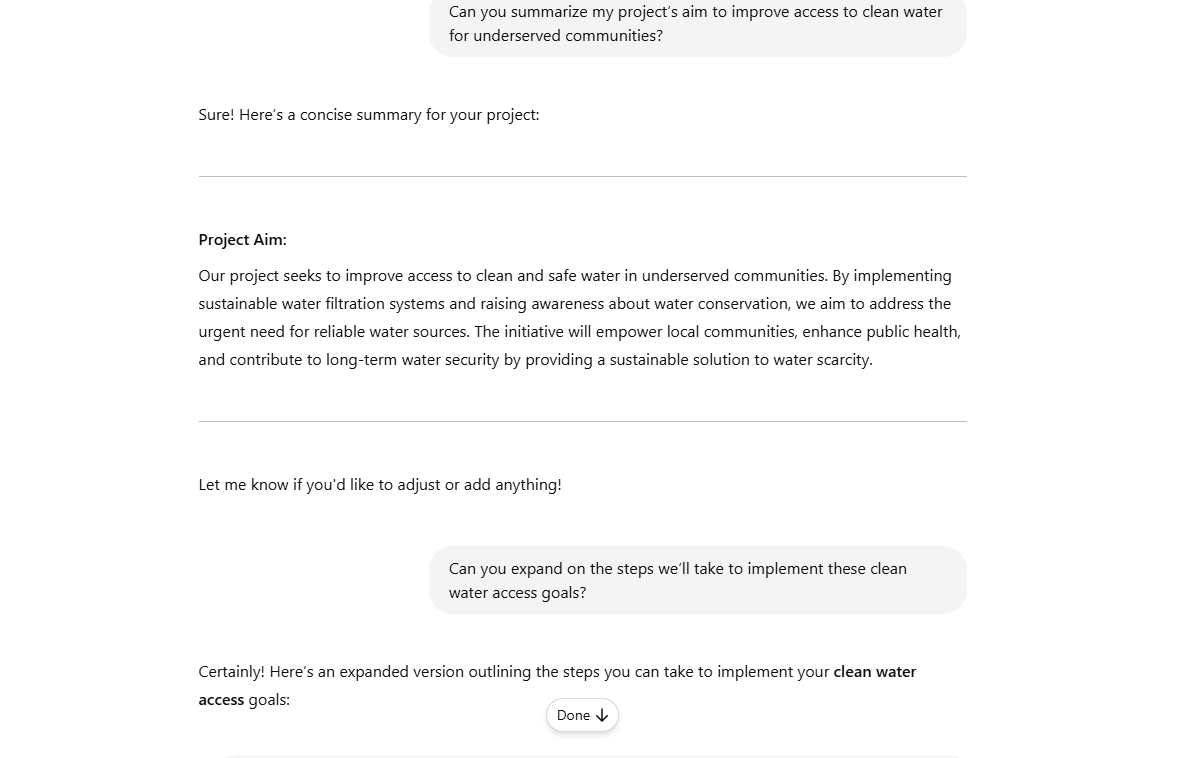
Example of Using Prompt Chaining
This technique is worth trying since you ask ChatGPT to adopt a specific role or persona to help you enhance your content.
You can use prompts like:
“Pretend you’re a grant writing expert. Can you help me write a compelling executive summary for a grant proposal focused on improving community health? Make it persuasive for funders who care about health and equity.”
Or:
“Imagine you’re a project evaluator just reading my grant proposal. What feedback would you give me on the methodology section to make it clear and appealing to funders?”
Try shifting your voice and see how it helps your proposal sound better.
ChatGPT is great, but it can become more powerful when combined with other tools, making your writing process more efficient.
For instance, from the text generated for your grant proposal, you can switch to a tool like Excel or Google Sheets to lay out your budget. After finalizing your proposal, use a tool like PowerPoint or Canva to create a visually appealing layout.
These straightforward steps and ChatGPT prompts for grant writing can help you secure the grant you seek! While crafting your letters, remember to communicate clearly and passionately about your project. Besides, don’t rely too much on AI. Instead, give human touches and maintain human oversight to ensure the content shows your organization’s voice.
Good luck on your grant writing journey! If you need more guidance or want to share your experience, feel free to connect with us in the comments below! Yes. ChatGPT can assist with various parts of grant writing, including drafting proposals, refining tone, structuring budgets, and generating letters of intent. Just make sure to provide clear context and human oversight. Yes. Grant writing is often complex and time-consuming due to strict guidelines and competitive requirements. That’s why using tools like ChatGPT can streamline the process and save time. Yes. You can use ChatGPT to draft a full grant proposal, from executive summaries to implementation plans. However, always review and customize the content to match your project’s goals and the funder’s expectations.
FAQs

